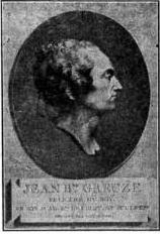
Jean-Baptiste Greuze
Encyclopedia
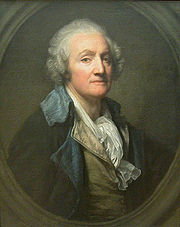
France
The French Republic , The French Republic , The French Republic , (commonly known as France , is a unitary semi-presidential republic in Western Europe with several overseas territories and islands located on other continents and in the Indian, Pacific, and Atlantic oceans. Metropolitan France...
painter
Painting
Painting is the practice of applying paint, pigment, color or other medium to a surface . The application of the medium is commonly applied to the base with a brush but other objects can be used. In art, the term painting describes both the act and the result of the action. However, painting is...
.
Early life
He was born at TournusTournus
Tournus is a commune in the Saône-et-Loire department in the region of Bourgogne in eastern France.-Geography:Tournus is located on the right bank of the Saône, 20 km. northeast of Mâcon on the Paris-Lyon railway.-Sights:...
, Saône-et-Loire
Saône-et-Loire
Saône-et-Loire is a French department, named after the Saône and the Loire rivers between which it lies.-History:When it was formed during the French Revolution, as of March 4, 1790 in fulfillment of the law of December 22, 1789, the new department combined parts of the provinces of southern...
. He is generally said to have formed his own talent; this is, however, true only in the most limited sense, for at an early age his inclinations, though thwarted by his father, were encouraged by a Lyonnese artist named Grandon, or Grondom, who enjoyed during his lifetime considerable reputation as a portrait-painter. Grandon not only persuaded the father of Greuze to give way to his sons wishes, and permit the lad to accompany him as his pupil to Lyon
Lyon
Lyon , is a city in east-central France in the Rhône-Alpes region, situated between Paris and Marseille. Lyon is located at from Paris, from Marseille, from Geneva, from Turin, and from Barcelona. The residents of the city are called Lyonnais....
, but, when at a later date he-himself left Lyon for Paris — where his son-in-law Grétry
André Ernest Modeste Grétry
André Ernest Modeste Grétry was acomposer from the Prince-Bishopric of Liège , who worked from 1767 onwards in France and took French nationality. He is most famous for his opéras comiques....
the celebrated composer enjoyed the height of favour — Grandon carried young Greuze with him.
Settled in Paris
Paris
Paris is the capital and largest city in France, situated on the river Seine, in northern France, at the heart of the Île-de-France region...
, Greuze worked from the living model in the school of the Royal Academy (Paris), but did not attract the attention of his teachers; and when he produced his first picture, "Le Père de famille expliquant la Bible a ses enfants," considerable doubt was felt and shown as to his share in its production. By other and more remarkable works of the same class Greuze soon established his claims beyond contest, and won for himself the notice and support of the well-known connoisseur La Live de Jully, the brother-in-law of Madame d'Epinay. In 1755 Greuze exhibited his "Aveugle trompé," upon which, presented by Pigalle
Jean-Baptiste Pigalle
Jean-Baptiste Pigalle was a French sculptor.He was born in Paris, the seventh child of a carpenter. Although he failed to obtain the Grand Prix, after a severe struggle he entered the Académie Royale and became one of the most popular sculptors of his day.His earlier work, such as Child with Cage ...
the sculptor, he was immediately agréé by the Academy.
Towards the close of the same year he left France for Italy
Italy
Italy , officially the Italian Republic languages]] under the European Charter for Regional or Minority Languages. In each of these, Italy's official name is as follows:;;;;;;;;), is a unitary parliamentary republic in South-Central Europe. To the north it borders France, Switzerland, Austria and...
, in company with the Abbé Louis Gougenot, who had deserted from the magistrature — although he had obtained the post of conseiller au Châtelet in order to take the petit collet. Gougenot had some acquaintance with the arts, and was highly valued by the Academicians, who, during his journey with Greuze, elected him an honorary member of their body on account of his studies in mythology
Mythology
The term mythology can refer either to the study of myths, or to a body or collection of myths. As examples, comparative mythology is the study of connections between myths from different cultures, whereas Greek mythology is the body of myths from ancient Greece...
and allegory
Allegory
Allegory is a demonstrative form of representation explaining meaning other than the words that are spoken. Allegory communicates its message by means of symbolic figures, actions or symbolic representation...
; his acquirements in these respects are said to have been largely utilized by them, but to Greuze they were of doubtful advantage, and he lost rather than gained by this visit to Italy in Gougenot's company. He had undertaken it probably in order to silence those who taxed him with ignorance of great models of style, but the Italian subjects which formed the entirety of his contributions to the Salon of 1757 showed that he had been put on a false track, and he speedily returned to the source of his first inspiration.
Relations with the Academy

Denis Diderot
Denis Diderot was a French philosopher, art critic, and writer. He was a prominent person during the Enlightenment and is best known for serving as co-founder and chief editor of and contributor to the Encyclopédie....
, "qui est un modèle d'honnêteté et d'estime; j'ai vu la réponse de Greuze, qui est un modèle de vanité et d'impertinence: il fallait appuyer cela d'un chef-d'œuvre, et c'est ce que Greuze n'a pas fait." (I have read the letter, which is a model of honesty and reverence; I have seen Greuze's response, which is a model of vanity and impertinence: he should have backed it up with a masterpiece, and that's precisely what he didn't do.)
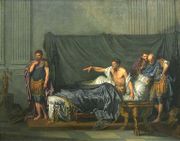

French Revolution
The French Revolution , sometimes distinguished as the 'Great French Revolution' , was a period of radical social and political upheaval in France and Europe. The absolute monarchy that had ruled France for centuries collapsed in three years...
had thrown open the doors of the Academy to all the world.
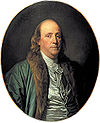
Jean-Jacques Rousseau
Jean-Jacques Rousseau was a Genevan philosopher, writer, and composer of 18th-century Romanticism. His political philosophy influenced the French Revolution as well as the overall development of modern political, sociological and educational thought.His novel Émile: or, On Education is a treatise...
's attacks upon an artificial civilization demanded expression in art.
Legacy

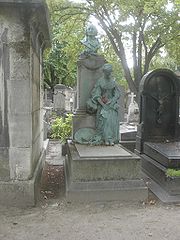
"La Jeune Fille à l'agneau" fetched, indeed, at the Pourtal's sale in 1865, no less than 1,000,000 francs. One of Greuze's pupils, Madame Le Doux, imitated with success the manner of her master; his daughter and granddaughter, Madame de Valory, also inherited some traditions of his talent. Madame de Valory published in 1813 a comédie-vaudeville, Greuze, ou l'accorde de village, to which she prefixed a notice of her grandfather's life and works, and the Salons of Diderot also contain, besides many other particulars, the story at full length of Greuze's quarrel with the Academy. Four of the most distinguished engravers of that date, Massard père, Flipart, Gaillard and Levasseur, were specially entrusted by Greuze with the reproduction of his subjects, but there are also excellent prints by other engravers, notably by Cars and Le Bas.

